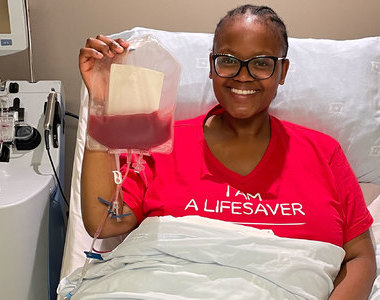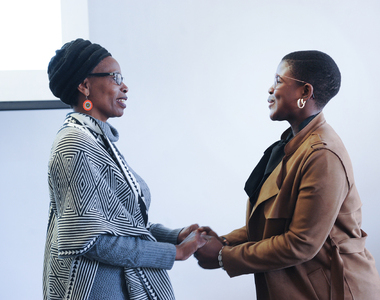Cross-sectional study spotlights unnerving findings on phantom limb pain
08 July 2024 | Story Niémah Davids. Photo Je’nine May. Voice Cwenga Koyana. Read time 6 min.
A whopping seven out of 10 patients who had undergone lower leg amputations in the Western Cape and Eastern Cape experience phantom limb pain – a painful sensation felt in the region of a limb that has recently been amputated.
On the back of this, a groundbreaking research study led by Dr Katleho Limakatso, an honorary research fellow in the University of Cape Town's (UCT) Department of Anaesthesia and Perioperative Medicine, found that a dearth of pre-amputation education and mental health support programmes at tertiary hospital level is to blame.
Dr Limakatso is currently completing his post-doctoral research fellowship at the Bionics Institute of the University of Melbourne. He said his latest work builds on a previous research study – a systematic review and meta-analysis that measured the global prevalence and risk factors of phantom limb pain in patients around the world. Similarly, he said, the global study (which pooled 37 surveys from various countries) also revealed that seven out of ten patients (64%) experience phantom limb pain.
“[But] no study at the time reported on the prevalence of phantom limb pain in the African context.”
“[But] no study at the time reported on the prevalence of phantom limb pain in the African context. And there was no way of extrapolating our global study findings and localising it, because of disparities in patient demographics and socio-economic determinants of pain between developed and developing nations,” he said.
Localising the pain
Limakatso was determined to localise this research and to broaden clinicians' understanding of phantom limb pain, which is why he brought it closer to home. His goal was to understand the burden of phantom limb pain among a sample of South African participants who had undergone lower limb amputations in public healthcare facilities. He interviewed 208 participants – 133 men and 75 women, recruited from Groote Schuur Hospital in Cape Town and Nelson Mandela Academic Hospital in Mthatha – to reach his findings.
The cross-sectional research study yielded some eye-opening outcomes. To start with, the prevalence of phantom limb pain among participants currently sits at 71.73%. In addition, Limakatso said, his research found that patients who were previously exposed to persistent pre-operative pain, residual limb pain (pain that affects the remaining part of the limb after an amputation) and existing non-painful phantom limb sensations were also at risk of phantom limb pain.
His research also revealed that most participants (57%) endured amputations above the knee due to uncontrolled diabetes (60%), critical limb ischaemia – a serious form of peripheral arterial disease that reduces blood flow and causes severe blockages (30%), infection (7%), trauma to the limb (2%), and cancer (1%).
Mitigating phantom limb pain
Yet the solution to mitigating phantom limb pain is quite straightforward, Limakatso said. Prioritising timely pre-operative interdisciplinary pain care is the answer. In addition, evidence-based pre-amputation education programmes and mental health support programmes aimed at patients pre- and post-amputation surgery have an important role to play. Such initiatives are essential – to explain what the amputation procedure entails, its effects, and what patients can expect post-procedure – to offer support and put their minds at ease.
“Our study indicates that the prevalence of phantom limb pain is high in the country.”
Sadly, Limakatso said, this approach is very rarely practised in public healthcare facilities in South Africa, due to resource constraints and overburdened healthcare workers, language barriers, and a lack of effective existing education programmes aimed directly at this patient profile.
“Our study indicates that the prevalence of phantom limb pain is high in the country. And healthcare professionals ought to be aware of this, and need to work together to implement strategies that will reduce and hopefully prevent it. It all starts with addressing the known risk factors associated with lower limb amputation that we’ve identified in this research study,” he said.
Breaking the cycle
Having reached these conclusions, Limakatso said, the work starts now to change the approach to care for amputees.
This, he said, requires designing and developing evidence-based education programmes in multiple South African languages, and facilitating their implementation across the country. Ideally, these programmes must focus on suggesting techniques to manage chronic diseases, and should highlight the importance of maintaining a healthy and well-balanced lifestyle. And because the psychosocial effects of amputations run deep, these programmes should also have a large mental health component.
Finally, Limakatso stressed that in order to succeed, this process requires the collective buy-in of all the clinicians involved, including the doctors, nurses, physiotherapists and social workers who work directly with patients pre- and post-amputation.
“What we need is to optimise peri-operative pain management to prevent post-surgical pain complications, minimise phantom limb pain, and improve the quality of life for our patients after surgery.”
“Now, knowing what we know about this debilitating condition, it will allow healthcare funders, clinicians, and other role-players to sit roundtable and to allocate resources towards managing post-amputation pain accordingly,” he said. “What we need is to optimise peri-operative pain management to prevent post-surgical pain complications, minimise phantom limb pain, and improve the quality of life for our patients after surgery.”
 This work is licensed under a Creative Commons Attribution-NoDerivatives 4.0 International License.
This work is licensed under a Creative Commons Attribution-NoDerivatives 4.0 International License.
Please view the republishing articles page for more information.
Listen to the news
The stories in this selection include an audio recording for your listening convenience.























































































































































































































































































































































































